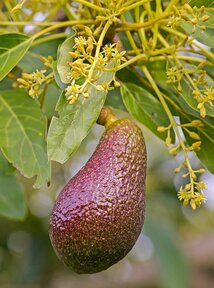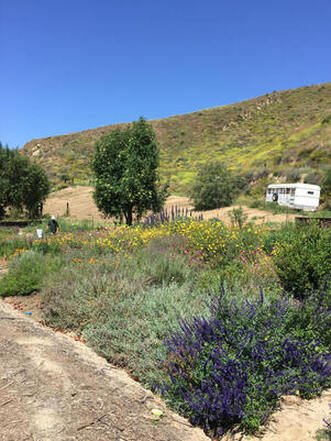Ventura Avocado Project, SoCal, 2014-Present

Avocado is a neotropic tree that has been commercialized world-wide, yet its native pollinators have been little studied. The most frequently studied pollinator has been the old-world honey bee, Apis mellifera. In commercial orchards it is common practice to introduce honey bee colonies, although it is not clear exactly what the extent of their effect is in California orchards in the presence of native bees and other pollinators. Purpose of this study is to evaluate the range of avocado flower visitors and to assess whether those numbers can be affected by introduction of pollinator habitat gardens that might promote their numbers in the orchards during the avocado bloom period. Focus of this investigation is at avocado orchards (called ranches locally) of Ventura County and vicinity of SoCal.
In Ventura County, two of the top 10 crops by value (Ventura County 2015 Annual Crop Report) -raspberries and avocados- require bee pollination to produce fruit, and others are enhanced by bee pollination (strawberries, lemons, tomatoes). Bee pollination is also critical to other important crops, such as citrus and the county’s growing blueberry industry. Native bees are often more efficient pollinators than honey bees hired to pollinate them.
In the urgency to educate the public, promote wild bee conservation, and ensure stable crops pollination, only a very few pollinator-friendly programs have been designed in the U.S. to attract and sustain wild bees. Yet, enormous gaps exist in our knowledge of the distribution and abundance of most species of wild pollinators. Regional and crop-specific information is almost nonexistent, and very little guidance is offered to help farmers adapt programs to their unique operations. Changes in weather patterns have already begun to impact emergence times of some bee species, as well as flowering times of crop and habitat plants, which further complicates efforts to selectively support target wild bee species and other potential pollinators such as flies, wasps, and possibly a few beetle species.
In Ventura County, two of the top 10 crops by value (Ventura County 2015 Annual Crop Report) -raspberries and avocados- require bee pollination to produce fruit, and others are enhanced by bee pollination (strawberries, lemons, tomatoes). Bee pollination is also critical to other important crops, such as citrus and the county’s growing blueberry industry. Native bees are often more efficient pollinators than honey bees hired to pollinate them.
In the urgency to educate the public, promote wild bee conservation, and ensure stable crops pollination, only a very few pollinator-friendly programs have been designed in the U.S. to attract and sustain wild bees. Yet, enormous gaps exist in our knowledge of the distribution and abundance of most species of wild pollinators. Regional and crop-specific information is almost nonexistent, and very little guidance is offered to help farmers adapt programs to their unique operations. Changes in weather patterns have already begun to impact emergence times of some bee species, as well as flowering times of crop and habitat plants, which further complicates efforts to selectively support target wild bee species and other potential pollinators such as flies, wasps, and possibly a few beetle species.
 Jim Lloyd Butler Ranch, Saticoy, CA
Jim Lloyd Butler Ranch, Saticoy, CA
In this research, we focus on three large avocado ranches in the general Ventura area of SoCal. Each of the three SoCal ranches used in the investigation are large enough to be divided into a treatment site and control site. Bee habitat gardens were constructed at the treatment sites; and control sites received no bee plants. The ranches are Ellwood Canyon Ranch in Goleta; Jim Lloyd Butler Ranch in Saticoy (near Camarillo); and Thille Ranch just west of the city of Santa Paula. Work at these farms started in 2014.
Encouraging results have emerged to date from our Ventura avocado project. Some of these include:
1) Based on annual bee monitoring at each ranch site from 2014-present, greater native bee diversity is always recorded in treatment versus control sites of the ranches.
2) Rare bee species have been collected in some of the monitored sites.
3) A total of 104 bee species have been collected to date from all ranch sites.
4) In addition to honey bees, 17 native bee species have been recorded visiting avocado flowers. Hover flies (common) also visit and may pollinate avocado flowers (these are new records for avocado pollination in SoCal).
5) Growers have been heavily involved in collaborating in establishing and maintaining the treatment sites (bee habitat gardens).
Encouraging results have emerged to date from our Ventura avocado project. Some of these include:
1) Based on annual bee monitoring at each ranch site from 2014-present, greater native bee diversity is always recorded in treatment versus control sites of the ranches.
2) Rare bee species have been collected in some of the monitored sites.
3) A total of 104 bee species have been collected to date from all ranch sites.
4) In addition to honey bees, 17 native bee species have been recorded visiting avocado flowers. Hover flies (common) also visit and may pollinate avocado flowers (these are new records for avocado pollination in SoCal).
5) Growers have been heavily involved in collaborating in establishing and maintaining the treatment sites (bee habitat gardens).
